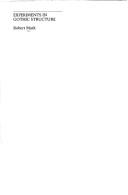| Listing 1 - 5 of 5 |
Sort by
|

ISBN: 0262131706 0262630958 9780262630955 Year: 1985 Publisher: Cambridge: MIT Press,
Abstract | Keywords | Export | Availability | Bookmark
 Loading...
Loading...Choose an application
- Reference Manager
- EndNote
- RefWorks (Direct export to RefWorks)
Gothic [Medieval] --- Religious architecture --- architecture [discipline] --- gotische architectuur --- anno 1200-1499 --- Architecture, Gothic. --- Architecture gothique --- Architecture, Gothic --- 72.03 --- 69 --- 69.01 --- 72.033 --- 72.033.5 --- Gothic architecture --- Christian antiquities --- Church architecture --- Bouwstijlen. Architectuurscholen. Architectuurstromingen. Bouwkunst: periodenen invloeden --- Architectuur (geschiedenis) --- Architectuurgeschiedenis --- Bouwtechniek --- Bouwconstructie --- Middeleeuwen (architectuur) --- Middeleeuwse architectuur --- Gotiek (architectuur) --- Gotische architectuur --- 72.03 Bouwstijlen. Architectuurscholen. Architectuurstromingen. Bouwkunst: periodenen invloeden --- Architecture --- 72.033.5 Gotische bouwkunst. Architectuur van de late-Middeleeuwen --- Gotische bouwkunst. Architectuur van de late-Middeleeuwen --- 72.011 --- Architectuur ; vormanalyse ; gotische kathedralen --- Architectuur ; gotiek ; structurele elementen --- Architectuurgeschiedenis ; Laat Middeleeuwse architectuur ; Gotiek --- Architectuur ; vormgeving, ontwerp, compositie
Book
ISBN: 026213246X Year: 1990 Publisher: Cambridge, Mass. The MIT Press
Abstract | Keywords | Export | Availability | Bookmark
 Loading...
Loading...Choose an application
- Reference Manager
- EndNote
- RefWorks (Direct export to RefWorks)
Robert Mark plumbs the mystery of the great buildings of ancient Rome, the High Gothic era, and the Renaissance, revealing the astonishing depth of knowledge the ancient builders possessed. His findings provide a stronger technological focus for architectural history and a basis for more rational criticism of contemporary design. The Sydney Opera House, with its vast cost overruns and its years of delay, is a glaring example of misbegotten notions of structural honesty. MIT's Kresge Auditorium was conceived for visual effect without regard for technological flaws that arose from the misapplied criteria of form-follows function and forced its closing for more than a year. And in the building of Boston's John Hancock Tower, structural imperatives, were literally thrown to the winds. These are just a few of the eases in which the role of technology in the design of a large scale building has been either neglected or confused. In this book Robert Mark shows how an understanding of the technology of historical architecture can illuminate, even help eliminate, such costly misconceptions. Mark focuses on three eras - ancient Rome, the era of structural experimentation in High Gothic architecture, and the time of the great Renaissance domes - that have had lasting impacts on architectural planning. He makes full use of sophisticated computer modeling to gain new insights into early design methods insights that allow him to reinterpret technological precedents that are often misunderstood in contemporary architecture. Mark's provocative findings provide a stronger technological focus for architectural history and a basis for more rational criticism of contemporary design.
Architectuurtheorie ; proportie ; compositie ; harmonie --- Architectuur & technologie ; Rome ; Gothiek en Renaissance --- Architectuur ; techniek, werkmethoden, behoud --- Architectuur ; theorie, filosofie, esthetica --- Engineering sciences. Technology --- architecture [discipline] --- structural engineering --- Architecture --- Structural engineering. --- Technological innovations. --- Composition, proportion, etc. --- Architectuur en ingenieurswetenschappen --- 72.02 --- 72.01 --- 72.03 --- Architectuurtheorie --- Architectuur (theorie) --- Architectuurgeschiedenis --- Génie civil --- Génie civil --- Histoire (discipline) --- technologische innovatie
Book
ISBN: 0830893431 9780830851423 0830851429 9780830893430 Year: 2016 Publisher: Downers Grove, IL
Abstract | Keywords | Export | Availability | Bookmark
 Loading...
Loading...Choose an application
- Reference Manager
- EndNote
- RefWorks (Direct export to RefWorks)
Islam --- Christianity and other religions --- Origin. --- Relations --- Christianity. --- Islam. --- Qurʼan --- Al-Coran --- Al-Qur'an --- Alcorà --- Alcoran --- Alcorano --- Alcoranus --- Alcorão --- Alkoran --- Coran --- Curān --- Gulan jing --- Karan --- Koran --- Koranen --- Korani --- Koranio --- Korano --- Ku-lan ching --- Ḳurʼān --- Kurāna --- Kurani --- Kuru'an --- Qorān --- Quräan --- Qurʼān al-karīm --- Qurʺon --- Xuraan --- Κοράνιο --- Каран --- Коран --- קוראן --- قرآن --- History. --- Criticism, interpretation, etc.
Book
ISBN: 8021076348 9788021076341 9788021063457 8021063459 Year: 2013 Publisher: Brno, Czech Republic : Masaryk University Press,
Abstract | Keywords | Export | Availability | Bookmark
 Loading...
Loading...Choose an application
- Reference Manager
- EndNote
- RefWorks (Direct export to RefWorks)
These volumes provide scholarly editions of Edward Perry Warren's works (all, save one, never before re-issued), augmented by a biographical introduction, extensive notes, translations, illustrations, and appendices. For the first time, Warren's voice is heard in full-through his correspondence and other residues that constitute his commissioned Edward Perry Warren: The Biography of a Connoisseur, through his conversation, captured in Osbert Burdett's An Imaginary Conversation, through his novel A Tale of Pausanian Love (published here for the first time) and his collection The Wild Rose: A Volume of Poems, through his fairy-tale The Prince Who Did Not Exist and his scholarly article The Scandal of the Museo di Villa Giulia, through his pamphlet Classical & American Education and his retelling of three Greek legends in Alcmaeon, Hypermestra, Caeneus, and through his magnum opus, the apologia A Defence of Uranian Love.
Art --- Gay men --- Art, Occidental --- Art, Primitive --- Art, Visual --- Art, Western (Western countries) --- Arts, Fine --- Arts, Visual --- Fine arts --- Iconography --- Occidental art --- Visual arts --- Western art (Western countries) --- Arts --- Aesthetics --- Collectors and collecting --- Warren, Edward Perry, --- Warren, Ned, --- Warren, E. P. --- Raile, Arthur Lyon,
Book
ISBN: 8021076356 9788021076358 9788021063464 Year: 2015 Publisher: Masarykova univerzita
Abstract | Keywords | Export | Availability | Bookmark
 Loading...
Loading...Choose an application
- Reference Manager
- EndNote
- RefWorks (Direct export to RefWorks)
| Listing 1 - 5 of 5 |
Sort by
|

 Search
Search Feedback
Feedback About UniCat
About UniCat  Help
Help News
News